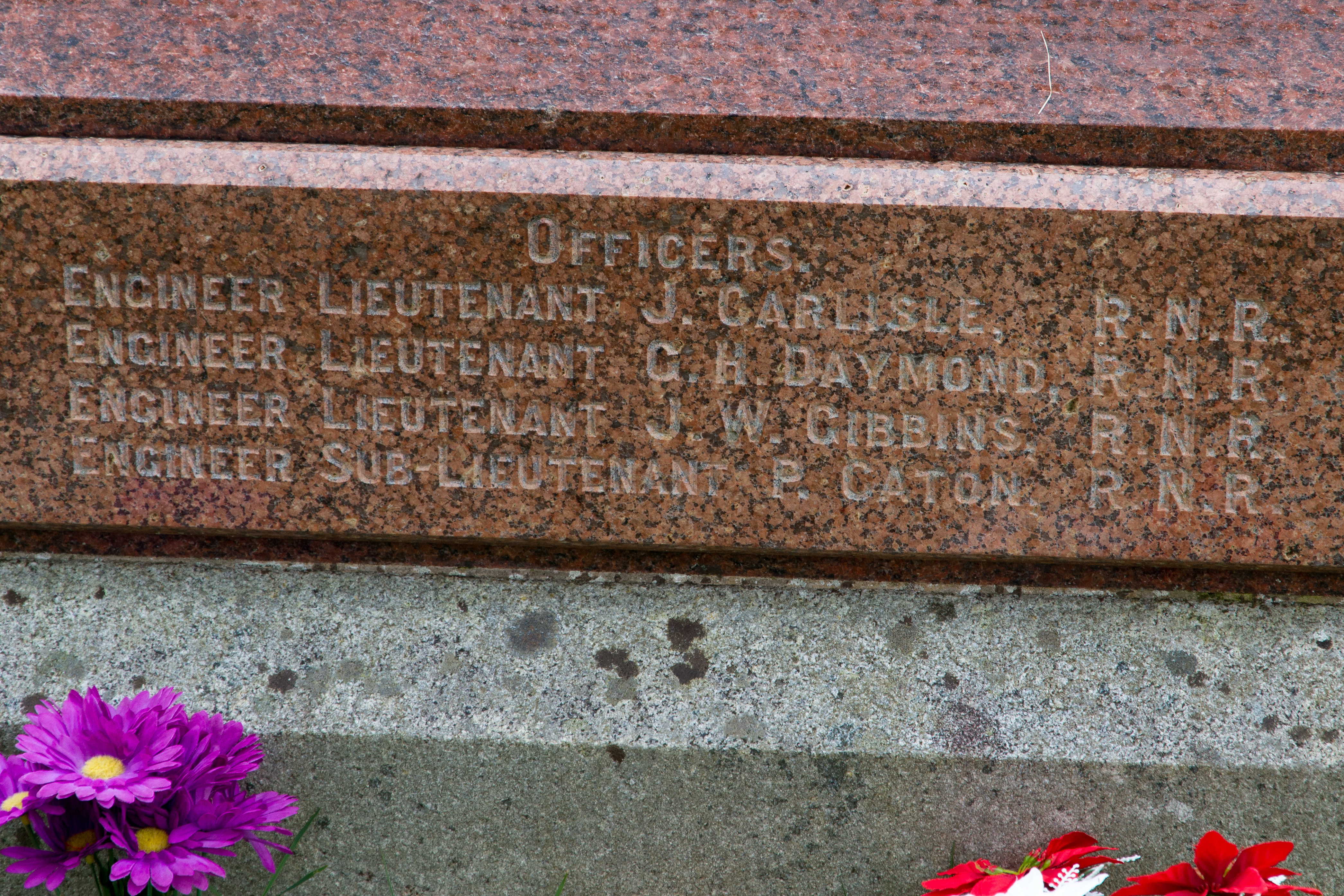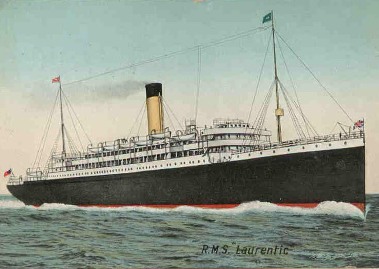 Military unit: Royal Naval Reserve (HMS Laurentic)
Military unit: Royal Naval Reserve (HMS Laurentic)
Date & place of birth: 5 March 1874 at Southsea, Hampshire
Date & place of death: 25 January 1917 (aged 45) off Malin Head, County Donegal, Republic of Ireland
James Carlisle was an officer in the Royal Naval Reserve and died following the sinking of HMS Laurentic off the coast of Ireland.
Family
James Carlisle was born on 5 March 1874 at 30 Campbell Road, Southsea, the first child of James Carlisle (1832–1905) and his wife Mary Agnes née Stares (1852–1900).
James Carlisle senior was originally from Woolwich in south-east London and enlisted in the Royal Navy in June 1853, aged 20. He quickly rose through the ranks, becoming Chief Engineer in October 1861. In 1873, he married Mary Stares (20 years his junior) in Portsmouth and their first child, James was born the following year.
James senior retired from the Royal Navy in October 1883 after 30 years’ service, with the rank of Fleet Engineer. At this time, the family were living at Clarence Villa, Purbrook, to the north of Portsmouth. Shortly after his retirement, the family (James and Mary with their first seven children, including 10 year old James junior) migrated to Canada and settled in London, Middlesex County, Ontario where a further six children were born over the next twelve years.
On leaving school, James junior served an engineering apprenticeship with E. Leonard & Sons, boilermakers, of London, Ontario.
On 27 December 1905, at St. John’s Church, Portsmouth, James Carlisle (aged 31) married Florence Edith Clegg (also aged 31). Florence was the daughter of Theophilus Clegg (1845–1910), who was a Seed Merchant, living at 41 London Road, Portsmouth.
James and Florence’s only child, James Clegg Carlisle was born at 41 London Road on 30 January 1908. Sadly, Florence died on 30 August 1911; her death certificate records that she died of tuberculosis at the Lunatic Asylum at Kingston, Portsmouth.
At the time of his death, James Carlisle was living at 2 Newton Road, Bitterne Park, Southampton.
Masonic career
On 12 February 1914, 39-year old James Carlisle was initiated into Royal Gloucester Lodge No 190 at Southampton, alongside Reginald Rowland, a 20-year old surveyor. The two men were passed together on 12 March, before James’s service with the Royal Naval Reserve prevented him making further Masonic progress. He was eventually raised to the degree of Master Mason at Duke of Edinburgh Lodge No 1182 at Liverpool on 11 February 1915.
Service in the Merchant Navy and Royal Naval Reserve
On completion of his apprenticeship, James joined the Merchant Navy with the Royal Mail Steam Package Company, where he stayed until December 1902, following which he moved to the Brocklebank Line, reaching the rank of Chief Engineer in April 1906.
In 1909, James joined White Star Line and on 9 November 1914 he was commissioned as an Engineer in the Royal Naval Reserve. The Royal Naval Reserve (RNR) had been created in 1859 as a reserve of professional seamen from the British Merchant Navy and fishing fleets, who would undertake annual training in gunnery etc. with the Royal Navy and be called out for service in the fleet in time of war.
James was promoted to (acting) Engineer Lieutenant on 23 March 1916.
Death
 By the end of 1916, James Carlisle was serving on the White Star Line’s SS Laurentic. Launched in 1908, Laurentic had operated on the Liverpool to Quebec service prior to the war. In early August 1914, before war was declared, Laurentic sailed from Liverpool to Canada with her accommodation full of fleeing Europeans. On 13 September, while at Montreal, she was commissioned as a troop transport for the Canadian Expeditionary Force, painted grey, and reclassified as HMS Laurentic. Later that year, she was converted into an auxiliary cruiser and fitted with seven cannon.
By the end of 1916, James Carlisle was serving on the White Star Line’s SS Laurentic. Launched in 1908, Laurentic had operated on the Liverpool to Quebec service prior to the war. In early August 1914, before war was declared, Laurentic sailed from Liverpool to Canada with her accommodation full of fleeing Europeans. On 13 September, while at Montreal, she was commissioned as a troop transport for the Canadian Expeditionary Force, painted grey, and reclassified as HMS Laurentic. Later that year, she was converted into an auxiliary cruiser and fitted with seven cannon.
On 23 January 1917, Laurentic departed Liverpool en route to Halifax, Nova Scotia, under the command of Captain Reginald Norton. She carried 479 passengers, mostly naval officers, ratings, and Naval Volunteer Reserves. In her strong rooms were 43 tons of gold, valued then at more than £5 million, being taken to the United States to pay for food, steel, and munitions which Britain needed to continue the war against Germany.
On 25 January, Laurentic made an unscheduled stop at the naval base in Buncrana, Ireland, to allow four passengers with yellow fever symptoms to disembark. The ship lifted anchor around sunset, moving toward Fanad Head, where she was to meet with a destroyer escort. The weather was bitterly cold and a blizzard affected visibility, but Captain Norton gave the order to proceed without the escort, despite reports that a German U-boat had been spotted in the area earlier. Less than an hour after leaving Buncrana, Laurentic struck two mines laid by the German submarine U-80 off Lough Swilly.
One of the mines exploded near the engine room, which left the ship without power and caused it to list 20 degrees; the combination of the darkness and list made it difficult to lower the lifeboats, and it was impossible for the ship to issue a distress call. Without power the main pumps were inoperable and the ship sank within an hour.
When the Laurentic struck the mines, James Carlisle was on watch. He made his way up to the boat deck and tried to help free the lifeboats, many of which were jammed as a result of the listing. After helping with the release of several of the lifeboats, James managed to get into No.7 lifeboat, but during the course of the rest of that bitterly cold, stormy night, died of exposure. The five survivors and the several dead in No.7 boat were picked up at 4.30 p.m., on the afternoon of 26 January 1917, by the trawler Farnaby.
Of the 475 men on board, only 121 survived and 354 men were lost in the disaster, 11 of whom were Freemasons, including Engineer Lieutenant James Carlisle.
Commemoration
 James Carlisle was buried in the mass grave for the Laurentic‘s victims in St Mura’s Graveyard at Fahan, in the north of County Donegal, Ireland.
James Carlisle was buried in the mass grave for the Laurentic‘s victims in St Mura’s Graveyard at Fahan, in the north of County Donegal, Ireland.
When the memorial to the men buried in St Mura’s was erected, James Carlisle’s name was misspelled ‘Carlyle’. After two years of negotiations with the Imperial War Graves Commission and the Admiralty by James’s brother Thomas, the error was eventually rectified.
James’s son, James Clegg Carlisle, aged 8, was now an orphan and went to live with his uncle Thomas in Montreal.
Sources
Ancestry.co.uk
1881 England Census
1891 Census of Canada
England & Wales, National Probate Calendar (Index of Wills and Administrations), 1858-1966
United Grand Lodge of England Freemason Membership Records, 1751–1921
CWGC Casualty Details: Engineer Lieutenant Carlisle, James
Find a Grave: Engineer Lieutenant James Carlisle
Hampshire Telegraph: 2 February 1917. Big Liner Lost
Jenkins, Roger. Royal Gloucester Lodge 130 History (2017)
Kindell, John. Royal Navy Roll of Honour – World War 1 (2009)
The Laurentic Legacy: James Carlisle
The London Gazette: 17 November 1914 Issue: 28977 Page: 9400
Masonic Roll of Honour: Engineer Lieutenant James Carlisle
The National Archives:
ADM 240/38/120 James Carlisle. Rank: Engineer Lieutenant (Temporary)
ADM 1/8589/93 HMS LAURENTIC. Enquiry regarding memorial erected to the officers and men of the crew
Wikipedia: SS Laurentic
Further reading on sinking of HMS Laurentic
Remembering the Laurentic tragedy 100 years on (Donegal County Council. 25 January 2017)
Photograph credits
E. Leonard & Sons advertisement: vintagemachinery.org
RMS Laurentic: Facebook: SS Laurentic … Gold Bullion Ship
Memorial: www.findagrave.com
